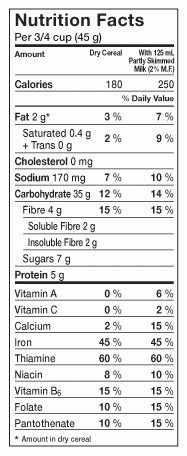5 Tips on Reading Nutrition Labels

Label reading is one way to ensure that the food choices we make for ourselves promote our health and wellbeing. There can be a lot of information on a nutrition label and it can feel overwhelming to understand what to look for! Here are some guidelines for interpreting nutrition labels.
Notice the Serving Size
Take note of the serving size (the amount for one serving) identified on the nutrition label. Next, compare your portion size (the amount you actually eat) to the serving size listed on the panel. For example, if the serving size is one cup and you eat two cups, you are getting twice the calories, fat and other nutrients listed on the label.
Percent Daily Values
The percentage of Daily Value (DV) gives you a quick understanding of the prevalence of a particular nutrient in the food. For example:
-
A Daily Value of 5 percent or less means that the food is “low” in a particular nutrient. Aim for foods that are “low” in total fat, saturated fat, trans fat, cholesterol and sodium.
-
A Daily Value of 20 percent or more means that the food is “high” in a particular nutrient. Choose foods that are “high” in vitamins, minerals and fiber.
Aim to Limit Fat, Cholesterol and Sodium
Eating less fat, cholesterol and sodium may help reduce your risk for heart disease, high blood pressure and cancer. Use the nutrition label to help identify foods high in bad fats, cholesterol and sodium and remember to aim for a low percentage of Daily Value for these nutrients.
Seek Out Vitamins, Minerals and Fiber
There are many health benefits to eating foods that are rich in fiber, vitamins and minerals like vitamin A, vitamin C, calcium and iron. These nutrients are also listed on the nutrition label and you want to select a high percentage of Daily Value for these nutrients. Keep in mind though, fruits and vegetables are some of the best sources of these important nutrients and they typically don’t have a label!
Look Over the Ingredient List
Ingredients are listed in descending order by weight on each nutrition label. That means that ingredients present in the largest amounts are listed first. This information can be helpful if you have food sensitivities or want to limit intake of added sugars, fat or salt. You may find that there are a lot of ingredients listed that you don’t recognize and this may sway the food choices you make while shopping.
Those few minutes spent reading and understanding a nutrition label does have an impact on your health. Be sure to invest that time on it because you’re worth it!
Jessica Stewart RD, BSc. | Baptist Housing Clinical Dietitian